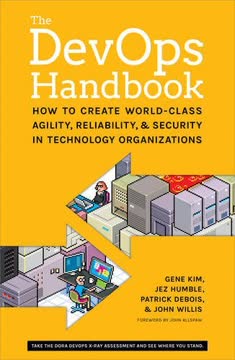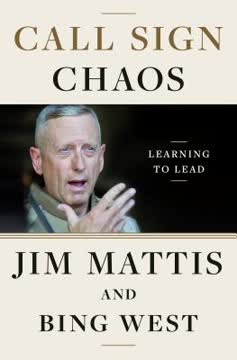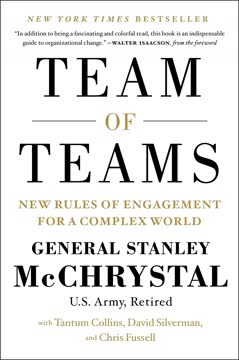Key Takeaways
1. Complex environments demand adaptable organizations
We had to tear down familiar organizational structures and rebuild them along completely different lines, swapping our sturdy architecture for organic fluidity, because it was the only way to confront a rising tide of complex threats.
The modern world is complex. Traditional organizational structures, designed for efficiency and predictability, are ill-equipped to handle the speed and interconnectedness of today's challenges. This complexity is characterized by:
- Rapid technological advancements
- Increased global connectivity
- Unpredictable events with far-reaching consequences
Adaptability is key to survival. Organizations must evolve to become more flexible, responsive, and resilient. This requires:
- Flattening hierarchies
- Encouraging cross-functional collaboration
- Developing the ability to quickly reconfigure resources and strategies
2. Traditional management models are insufficient for modern challenges
Our situation was not an exception—it is the new norm.
Taylorism is outdated. Frederick Winslow Taylor's scientific management principles, which emphasize efficiency and top-down control, are no longer effective in complex environments. The limitations of traditional management include:
- Rigid hierarchies that slow decision-making
- Siloed departments that hinder information flow
- Overemphasis on efficiency at the expense of adaptability
New approaches are necessary. Organizations must embrace management models that prioritize:
- Agility and quick response times
- Decentralized decision-making
- Continuous learning and adaptation
3. Building a "team of teams" requires shared consciousness and empowered execution
We needed to create a team of teams—an organization within which the relationships between constituent teams resembled those between individuals on a single team: teams that had traditionally resided in separate silos would now have to become fused to one another via trust and purpose.
Shared consciousness is the foundation of a team of teams. It involves:
- Creating a common understanding of the organization's mission and challenges
- Fostering a culture of transparency and open communication
- Developing systems for rapid information sharing across the organization
Empowered execution enables teams to act quickly and effectively. This requires:
- Pushing decision-making authority to the lowest appropriate level
- Trusting teams to make informed choices based on their expertise and situational awareness
- Providing teams with the resources and support they need to succeed
4. Trust and purpose are essential for high-performing teams
The SEAL team in Abbottabad had not planned for the helicopter crash, just as Captain Sullenberger's crew had not planned for the bird strike, and the Carty-Caterson team had not planned for the marathon bombing, but all were capable of adjusting to the unexpected with creative solutions on the spot, coherently and as a group.
Trust enables rapid adaptation. High-performing teams can respond effectively to unexpected challenges because:
- Team members understand each other's capabilities and limitations
- There is a shared belief in the team's ability to overcome obstacles
- Open communication allows for quick problem-solving and decision-making
Shared purpose aligns efforts. Teams with a clear, compelling purpose:
- Are more motivated to overcome challenges
- Can make decisions that align with overarching goals
- Are better able to coordinate their actions without explicit direction
5. Effective information sharing is crucial for organizational adaptability
We were stronger, more efficient, more robust. But AQI was agile and resilient. In complex environments, resilience often spells success, while even the most brilliantly engineered fixed solutions are often insufficient or counterproductive.
Information is power. In complex environments, the ability to quickly gather, analyze, and disseminate information is critical. Effective information sharing:
- Enables faster decision-making
- Improves situational awareness across the organization
- Helps identify emerging threats and opportunities
Breaking down silos is essential. Organizations must overcome barriers to information flow by:
- Creating cross-functional teams and communication channels
- Implementing technologies that facilitate rapid information sharing
- Fostering a culture that values transparency and collaboration
6. Leaders must shift from "commanding" to "gardening"
The gardener creates an environment in which the plants can flourish.
Traditional leadership is insufficient. In complex environments, leaders cannot control every aspect of their organization. Instead, they must:
- Create conditions that allow teams to thrive
- Provide guidance and resources rather than micromanaging
- Foster a culture of trust, learning, and adaptation
The gardener approach to leadership involves:
- Nurturing talent and fostering growth
- Removing obstacles and creating opportunities
- Continuously monitoring and adjusting the organizational ecosystem
7. Resilience trumps efficiency in unpredictable environments
Efficiency remains important, but the ability to adapt to complexity and continual change has become an imperative.
Efficiency alone is not enough. While streamlined processes and cost-cutting measures are valuable, they can make organizations brittle and vulnerable to disruption. Resilience involves:
- Building redundancy and slack into systems
- Developing the ability to quickly reconfigure resources
- Fostering a culture of experimentation and learning from failure
Balancing efficiency and resilience is crucial. Organizations should:
- Identify critical functions that require redundancy
- Invest in adaptable technologies and processes
- Develop diverse skill sets and capabilities among team members
8. Empowering decision-making at all levels enhances organizational effectiveness
We concluded that we would be better served by accepting the 70 percent solution today, rather than satisfying protocol and getting the 90 percent solution tomorrow.
Decentralized decision-making improves responsiveness. By pushing authority to lower levels, organizations can:
- React more quickly to changing conditions
- Leverage the expertise of frontline employees
- Reduce bottlenecks in decision-making processes
Empowerment requires preparation. To effectively decentralize decision-making:
- Ensure all team members understand the organization's mission and goals
- Provide training and resources to support informed decision-making
- Establish clear boundaries and guidelines for autonomous action
9. Transparency and open communication foster adaptability and innovation
Our standing guidance was "Share information until you're afraid it's illegal."
Transparency builds trust. Open communication within an organization:
- Encourages collaboration and idea-sharing
- Reduces duplication of efforts
- Helps identify and address problems more quickly
Overcoming barriers to transparency is crucial. Organizations must:
- Challenge the "need to know" mentality
- Implement technologies that facilitate information sharing
- Reward and recognize those who contribute to organizational knowledge
10. Organizational structure should mirror the complexity of the operating environment
Our organization, like Taylor's, visually mirrored the technologies of the time. While Taylor developed orderly, machinelike organizational forms to make the most of the orderly machines in his factories, our network resembled the snaking, overlapping, constantly shifting structural makeup of the Web.
Form follows function. Organizational structures should be designed to handle the complexity of their environment. This may involve:
- Flattening hierarchies to increase responsiveness
- Creating flexible, cross-functional teams
- Developing networks of interconnected units rather than rigid departments
Continuous adaptation is necessary. As the operating environment evolves, organizations must:
- Regularly reassess their structure and processes
- Be willing to experiment with new organizational forms
- Foster a culture that embraces change and adaptation
Last updated:
FAQ
What's Team of Teams about?
- Adaptability Focus: Team of Teams by Stanley McChrystal emphasizes the need for organizations to adapt to complex and rapidly changing environments. It draws from McChrystal's military experiences, particularly in Iraq.
- Military Insights: The book uses real-life military scenarios to illustrate the importance of evolving from traditional command structures to more flexible, team-oriented approaches.
- Team of Teams Concept: It introduces the idea of creating a "team of teams," where small, adaptable units work together seamlessly, sharing information and resources to respond to threats more effectively.
Why should I read Team of Teams?
- Modern Relevance: The insights are applicable to various sectors, including business and healthcare, offering a framework for leaders to foster adaptability and resilience.
- Practical Strategies: Readers gain actionable advice on breaking down silos and enhancing collaboration within organizations, empowering teams to make real-time decisions.
- Inspiring Leadership Lessons: McChrystal’s experiences provide valuable lessons on leadership, trust, and the importance of a shared mission, offering a unique perspective on leading in challenging environments.
What are the key takeaways of Team of Teams?
- Adaptability Over Efficiency: Organizations must prioritize adaptability over mere efficiency to succeed in complex environments.
- Trust and Purpose: Building trust and a shared sense of purpose among team members is crucial for effective collaboration and mission success.
- Networked Structure: The "team of teams" approach highlights the need for organizations to function as interconnected networks rather than rigid hierarchies.
What are the best quotes from Team of Teams and what do they mean?
- “It takes a network to defeat a network.”: This quote emphasizes the need for collaborative, networked approaches to tackle modern challenges.
- “We do these things, not because they are easy, but because they are hard.”: Reflects the spirit of perseverance and the willingness to tackle difficult challenges for growth.
- “The common denominator of the professionals with whom I served was an almost mystical devotion to mission accomplishment.”: Highlights the importance of a shared mission and collective dedication for success.
How does Team of Teams define complexity?
- Complexity vs. Complicated: Distinguishes between systems that are predictable and those with numerous interdependent variables, making prediction difficult.
- Interconnectedness and Speed: Complexity arises from increased interconnectedness and rapid change, where small actions can have large, unpredictable consequences.
- Need for Adaptability: Organizations must adapt quickly to changing circumstances, as traditional management approaches are insufficient for navigating complexity.
What is the "team of teams" approach in Team of Teams?
- Collaborative Structure: Involves creating a network of small, autonomous teams working towards a common goal, allowing for flexibility and responsiveness.
- Shared Consciousness: Emphasizes the importance of all teams having access to relevant information and understanding the broader context of their actions.
- Empowered Execution: Team members are empowered to act based on their understanding of the situation, fostering innovation and adaptability.
How does Team of Teams suggest organizations can improve communication?
- Increase Transparency: Advocates for transparency within organizations to ensure all team members have access to necessary information, facilitating collaboration.
- Break Down Silos: Emphasizes breaking down silos between departments to enhance communication and improve response to complex challenges.
- Encourage Open Dialogue: Leaders should promote an environment where team members feel comfortable sharing ideas and feedback to enhance trust and collaboration.
What role does leadership play in the Team of Teams framework?
- Facilitator of Collaboration: Leaders create an environment conducive to collaboration and adaptability, empowering team members to make decisions.
- Building Trust: Effective leaders focus on building trust among team members, essential for fostering a cohesive team environment.
- Adapting Leadership Style: Leaders must adapt their style to fit complex environments, moving away from command-and-control to a more decentralized model.
How does Team of Teams address the concept of resilience?
- Capacity to Absorb Disturbance: Resilience is the ability to absorb disturbances while maintaining core functions, crucial for organizational adaptability.
- Building Resilient Systems: Organizations should focus on creating systems that can withstand shocks, fostering a culture of adaptability and learning from failures.
- Learning from Experience: Continuous learning and improvement enhance resilience, with organizations embracing experimentation and adaptation.
How did the Task Force transform according to Team of Teams?
- From Silos to Networks: The Task Force shifted from a hierarchical structure to a networked approach, improving communication and collaboration.
- Integration of Intelligence and Operations: Facilitated a cohesive strategy, enabling rapid decision-making and execution against AQI.
- Cultural Change: Trust, transparency, and shared purpose became central, empowering individuals to take initiative and act decisively.
What is empowered execution in Team of Teams?
- Decentralized Authority: Refers to delegating decision-making authority to individuals at all levels, allowing for faster responses to challenges.
- Trust in Competence: Leaders trust their teams to make sound decisions based on expertise and situational awareness.
- Real-Time Decision Making: Enables teams to act quickly based on real-time information, crucial in fast-paced environments.
What are the implications of Team of Teams for future leadership?
- Evolving Leadership Roles: Leaders must adapt to a decentralized and collaborative approach, focusing on nurturing team dynamics and trust.
- Emphasis on Contextual Awareness: Creating shared consciousness ensures all members have the information needed for informed decisions.
- Gardener vs. Chess Master: Leaders should cultivate an environment where teams can thrive, enabling adaptability and resilience.
Review Summary
Team of Teams receives mostly positive reviews for its insights on organizational dynamics and leadership. Readers appreciate McChrystal's approach to adapting military structures for complex environments, emphasizing shared consciousness and decentralized decision-making. Many find the book well-written and engaging, with relevant anecdotes and practical examples. Some criticize its repetitiveness and length, while others praise its applicability to business settings. Overall, reviewers commend the book for its valuable lessons on creating agile, resilient organizations in today's rapidly changing world.
Similar Books










Download PDF
Download EPUB
.epub digital book format is ideal for reading ebooks on phones, tablets, and e-readers.





